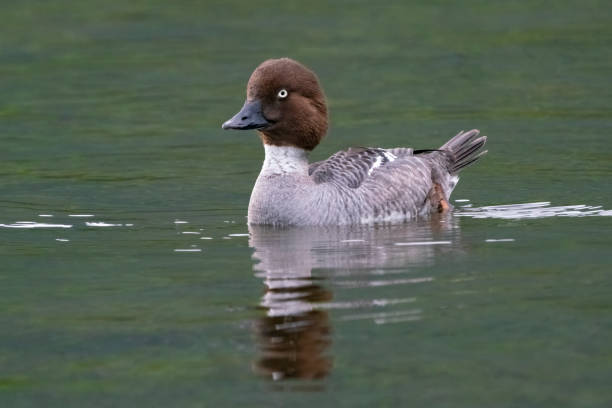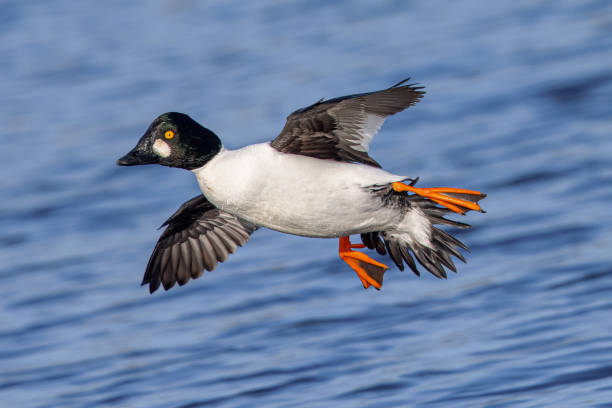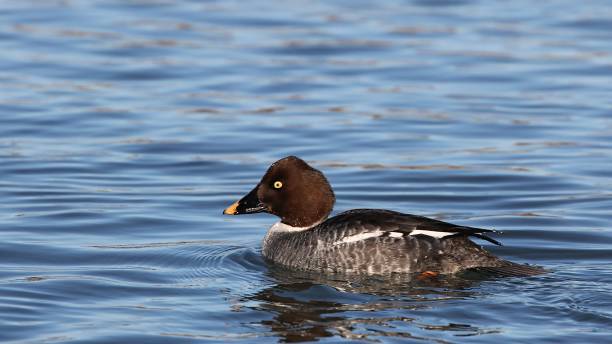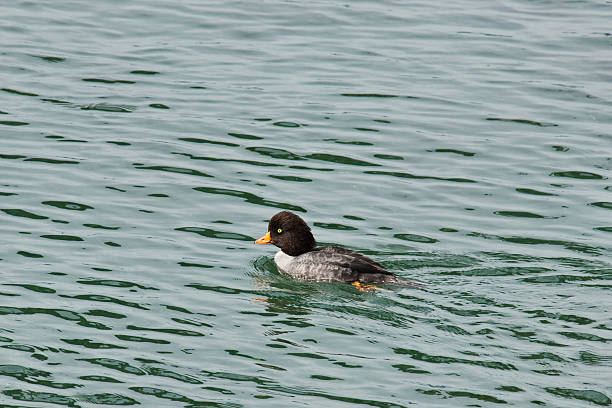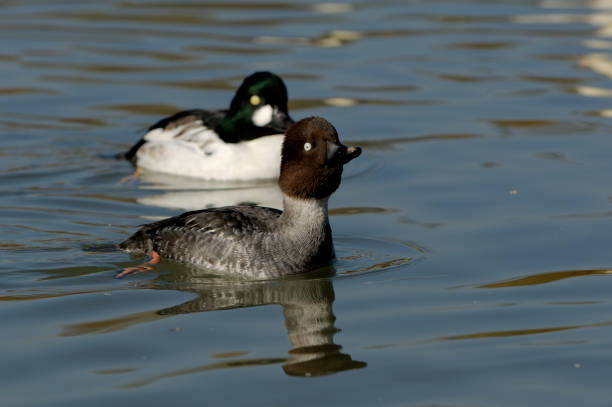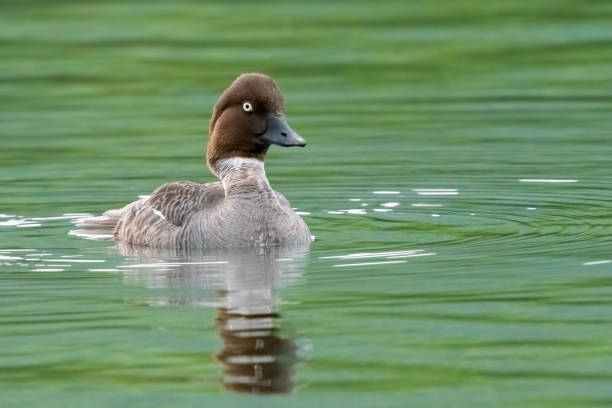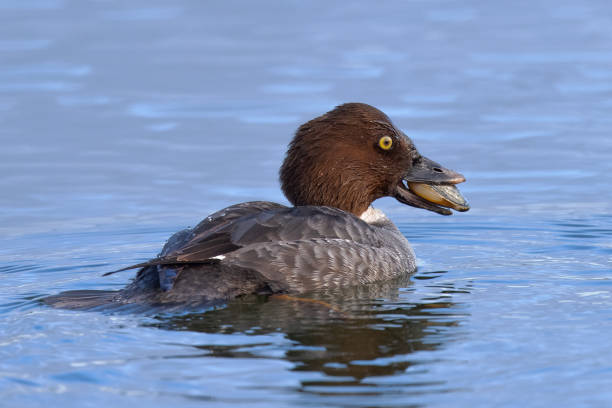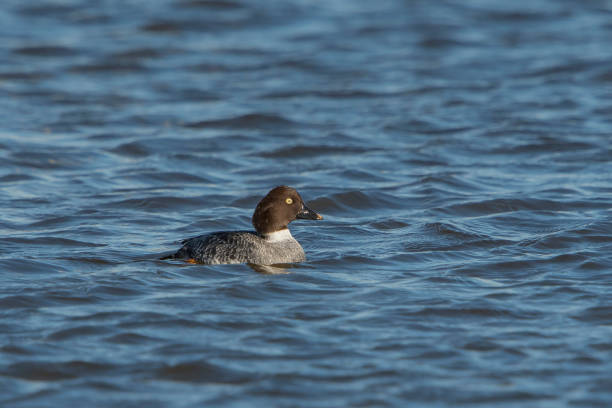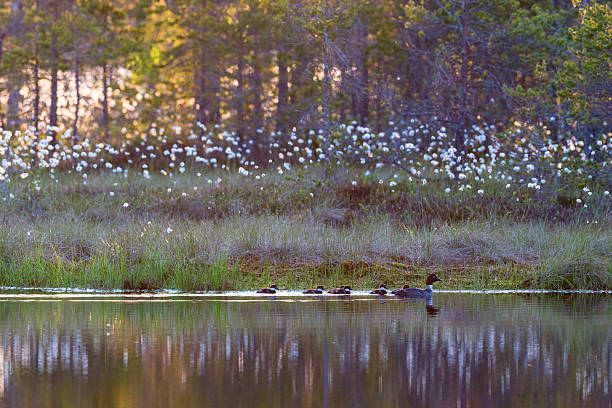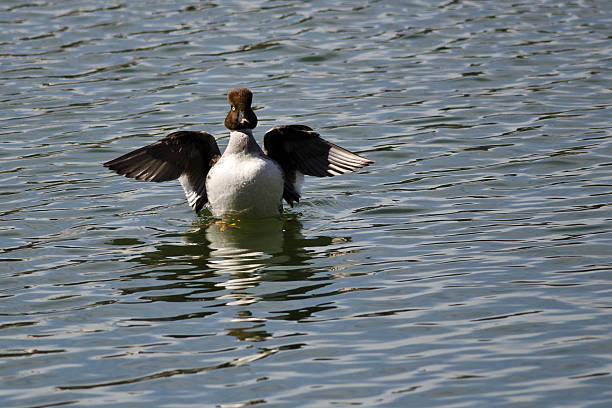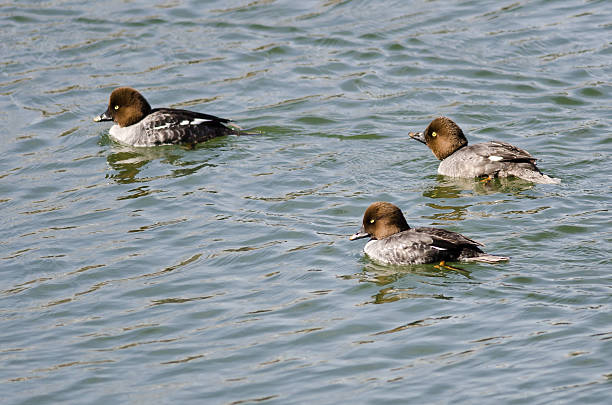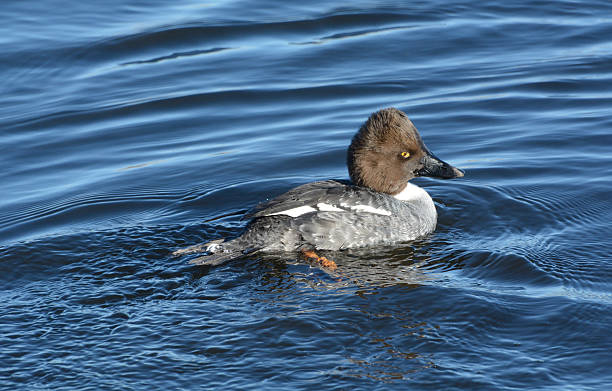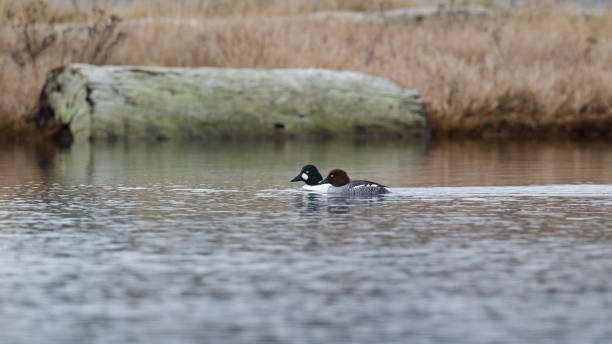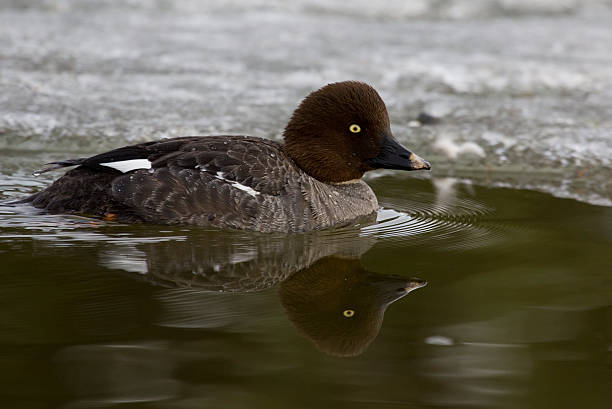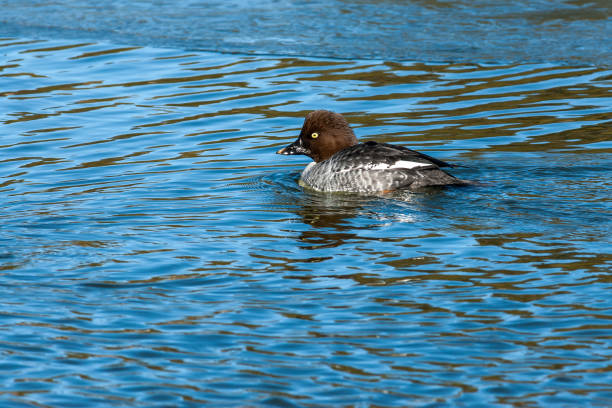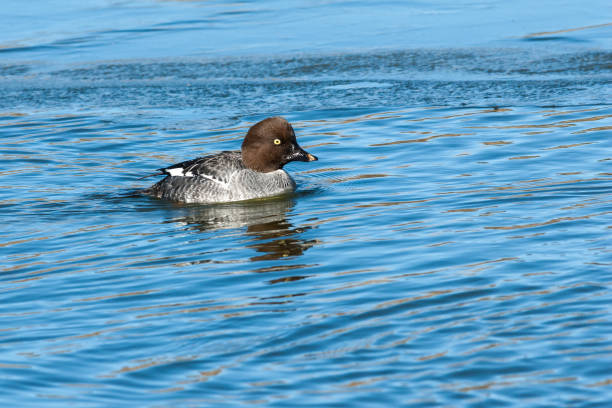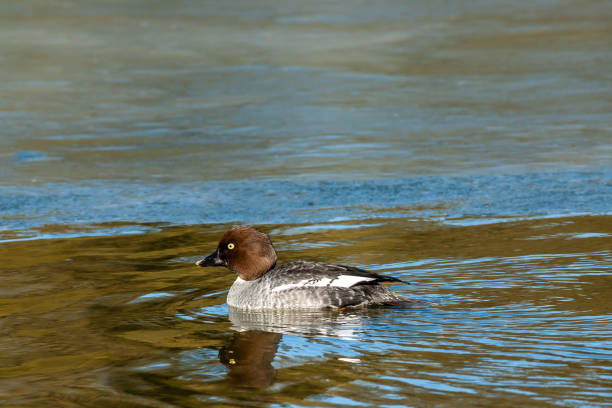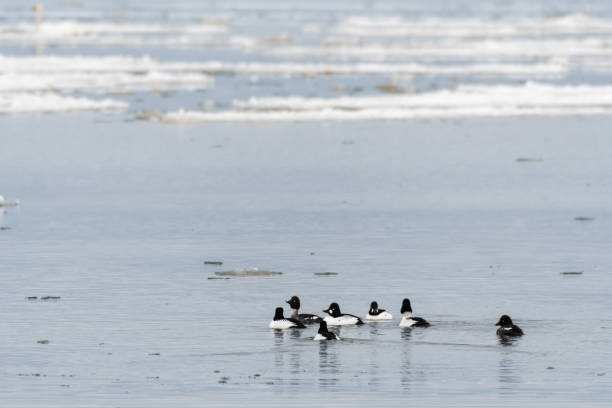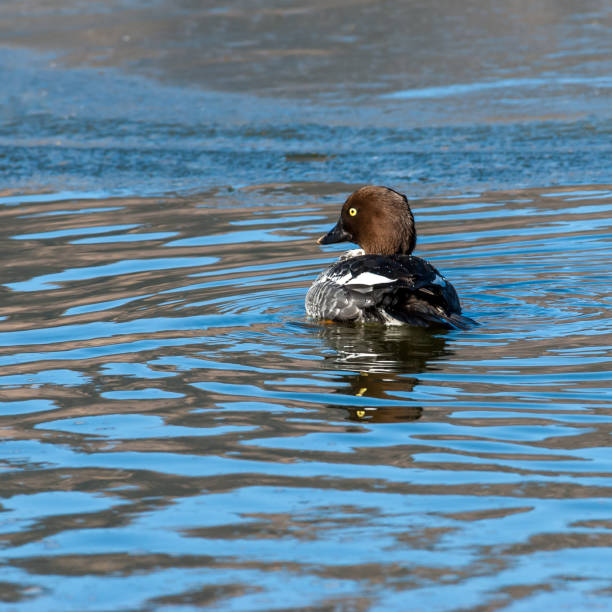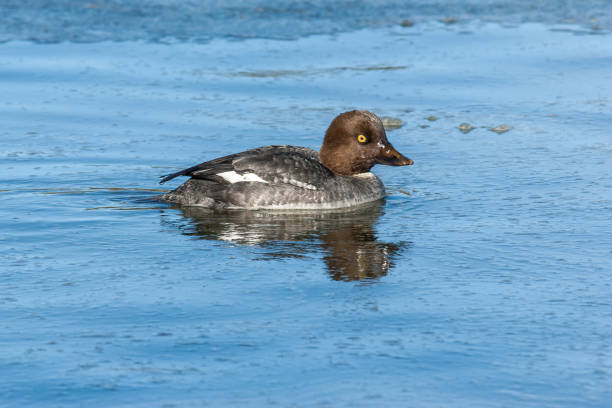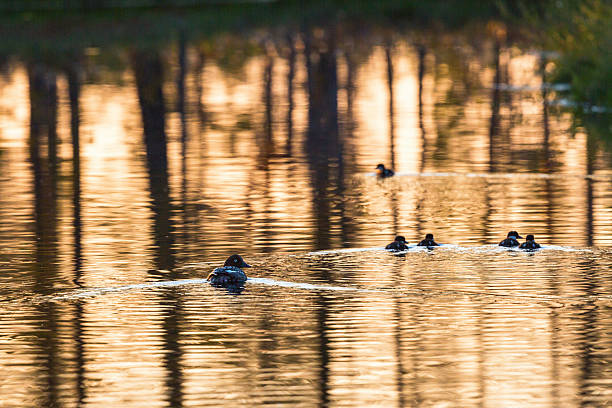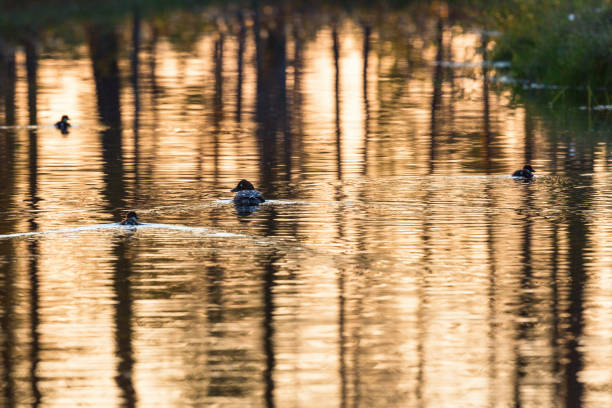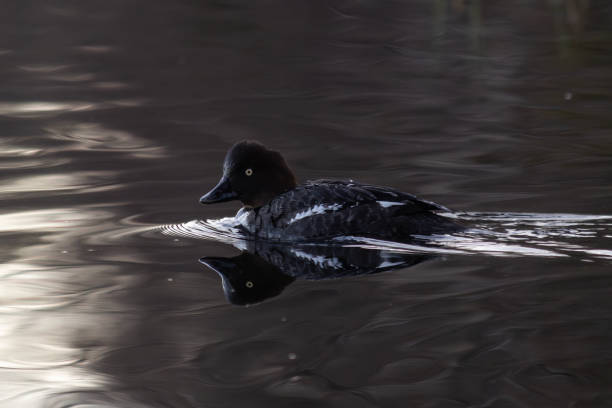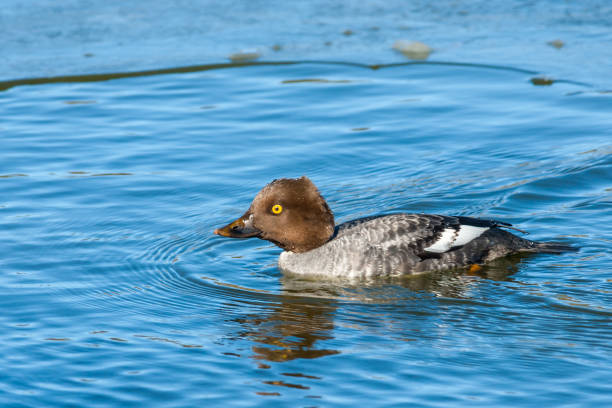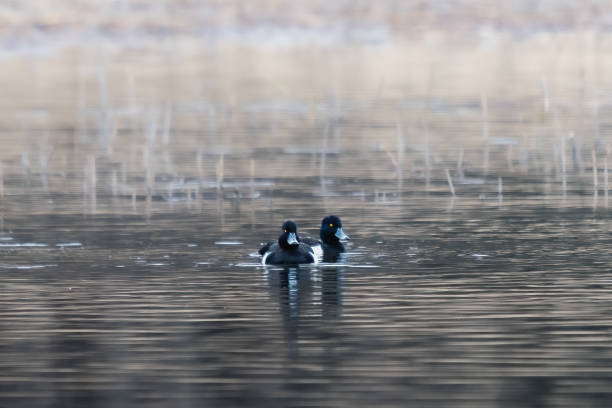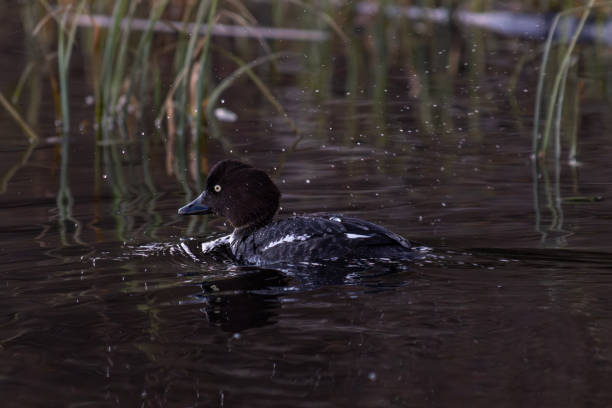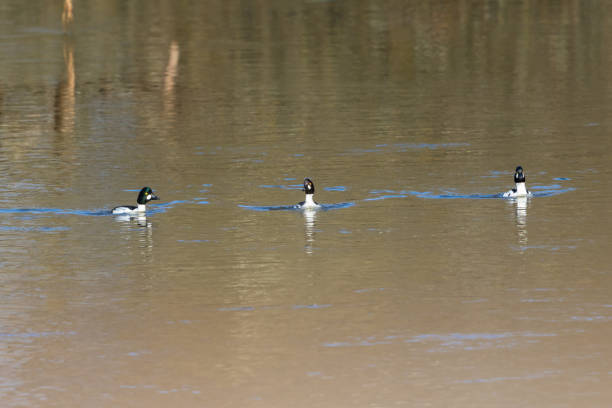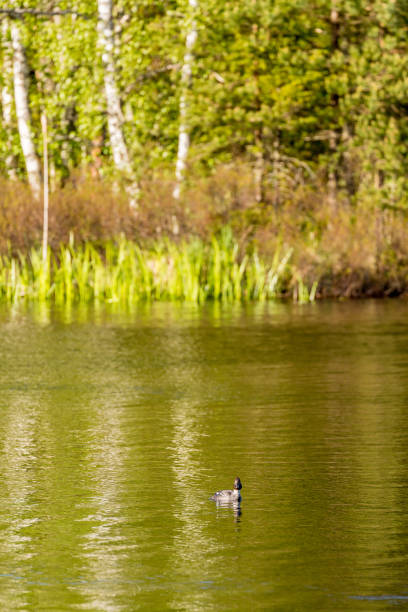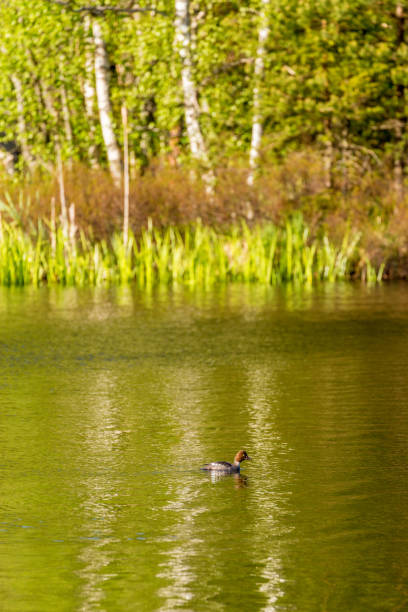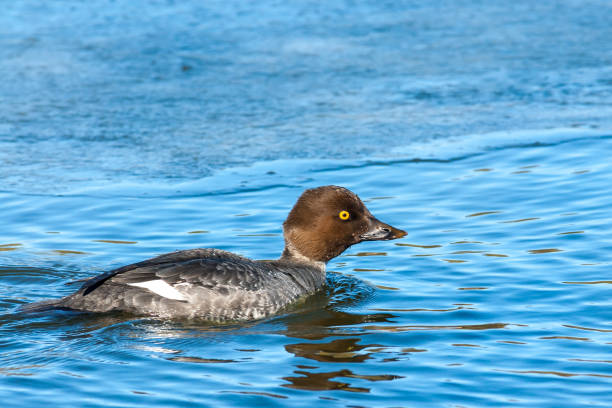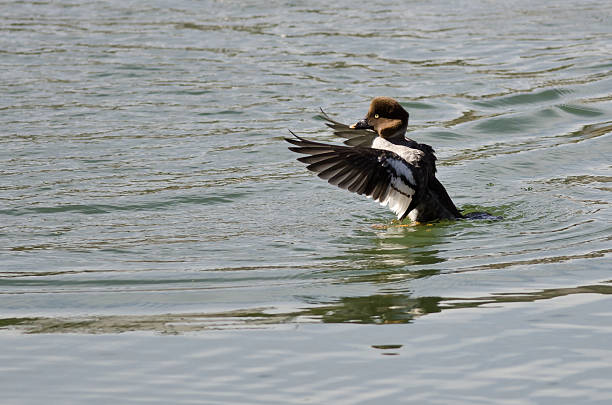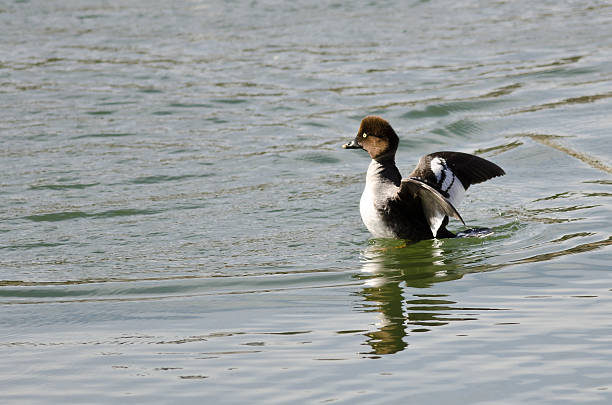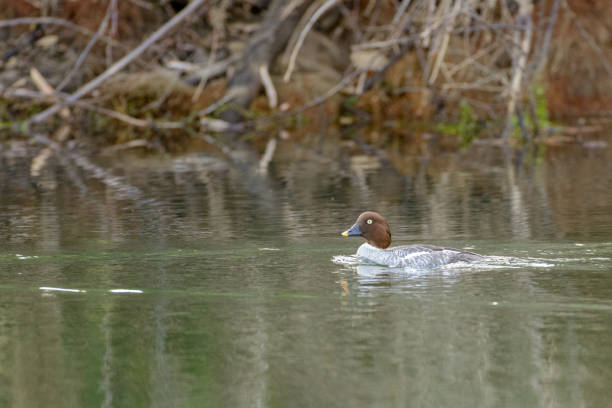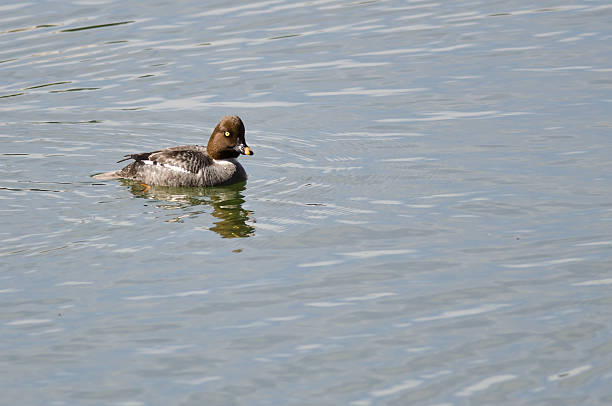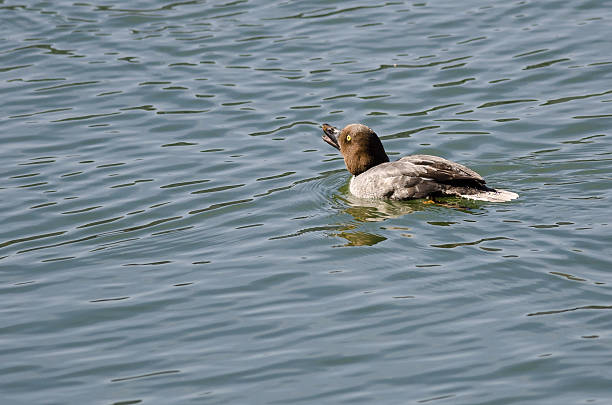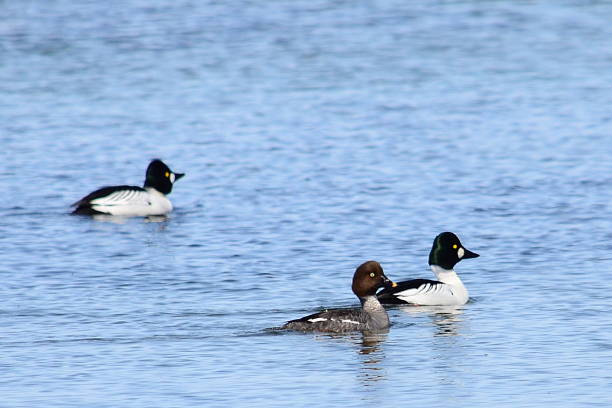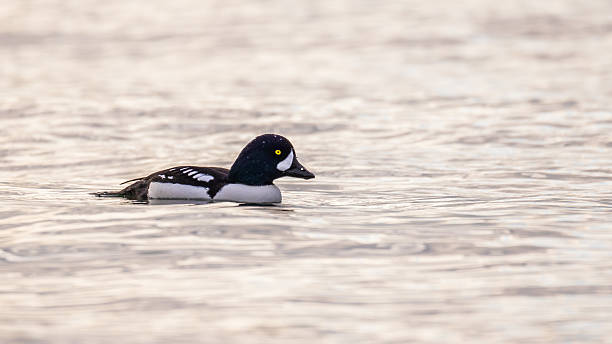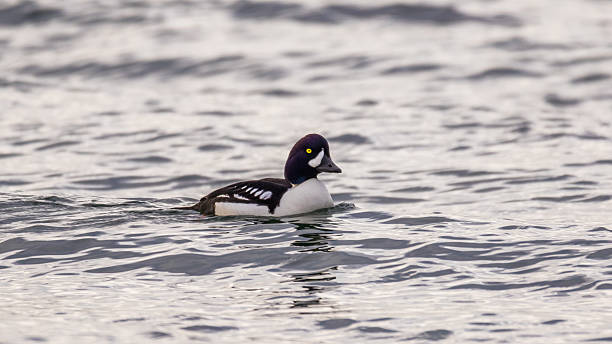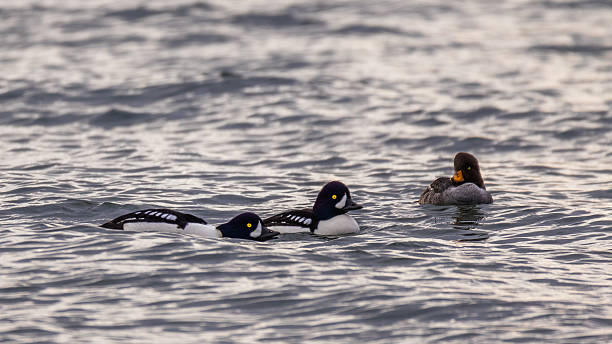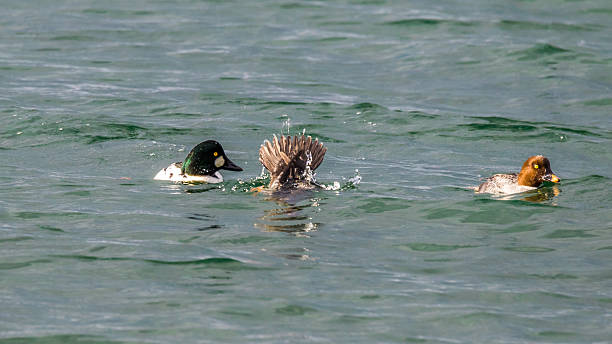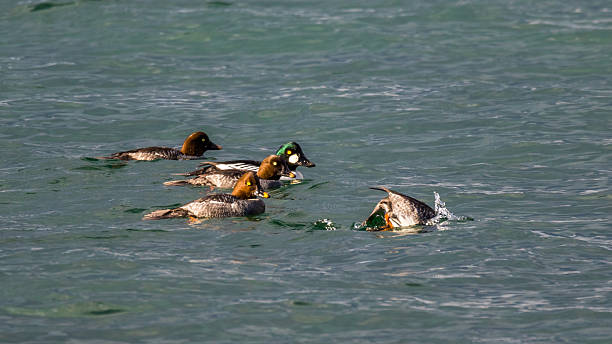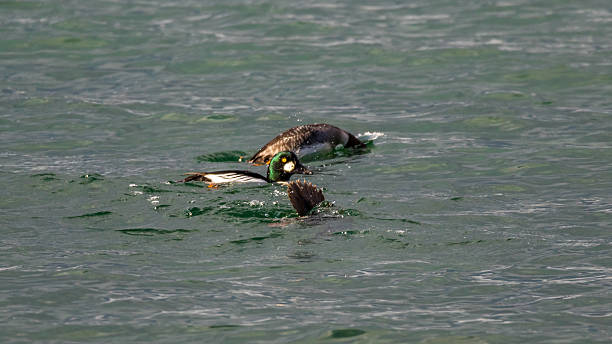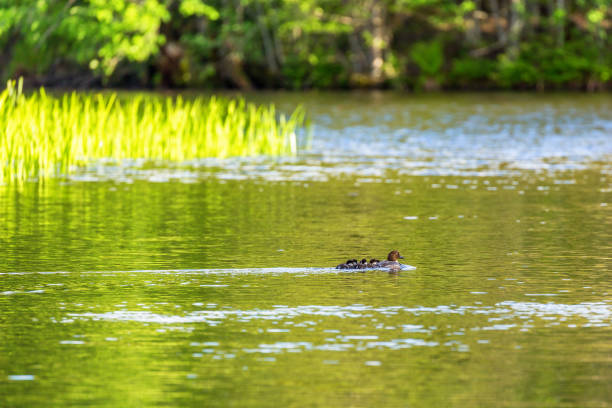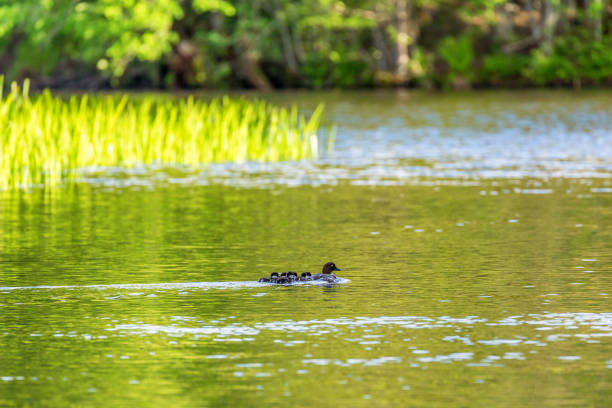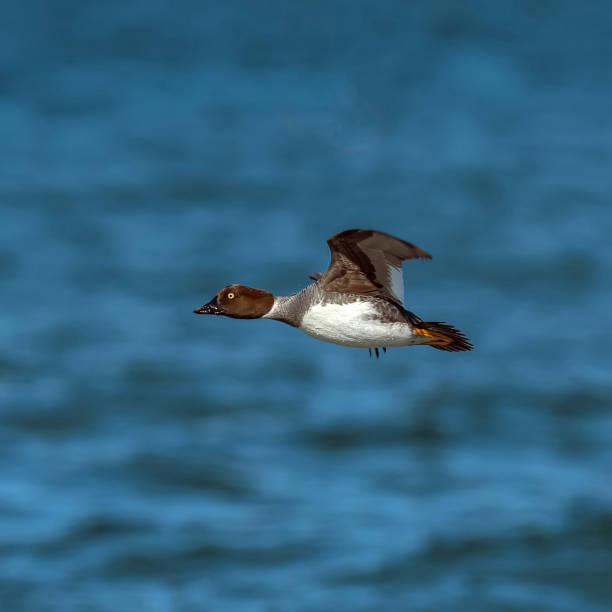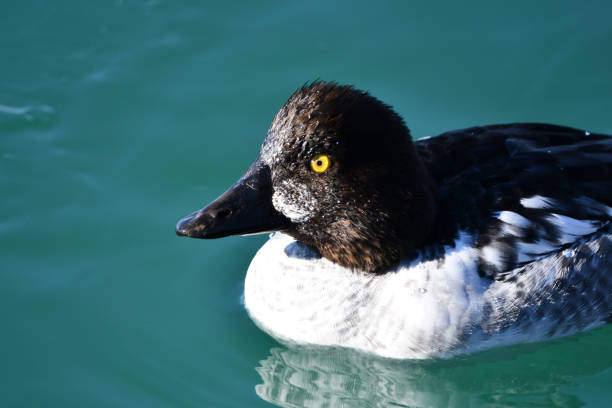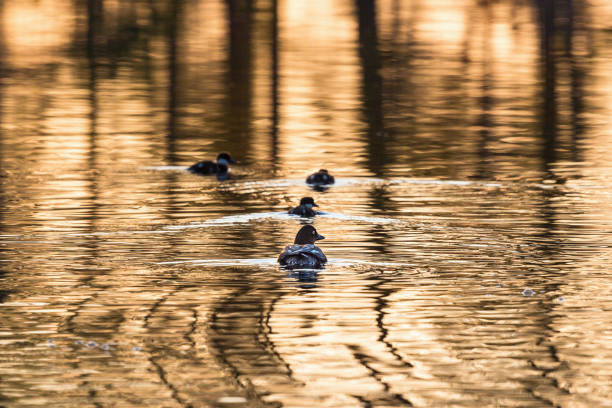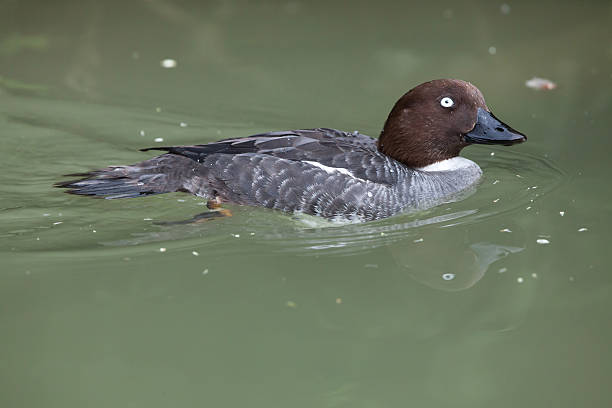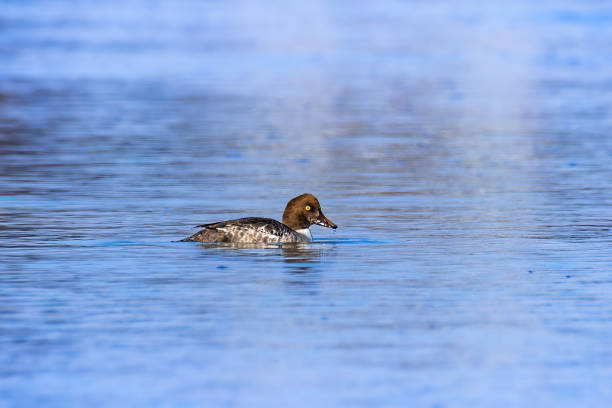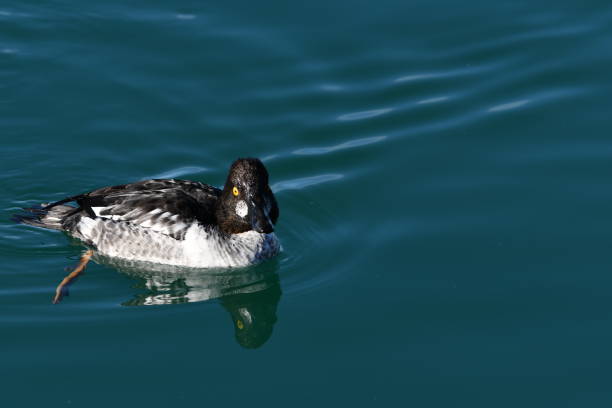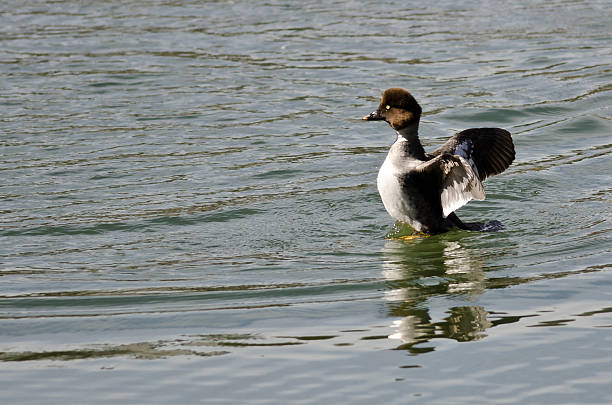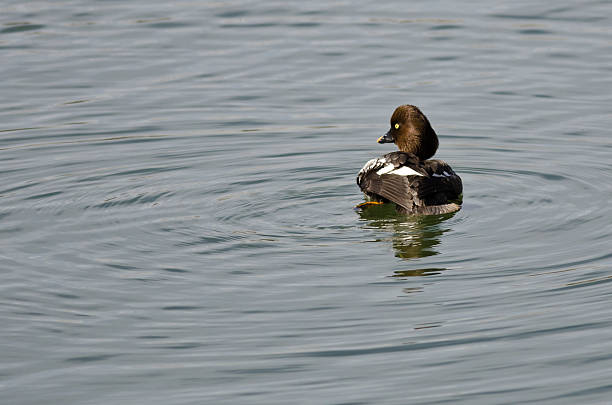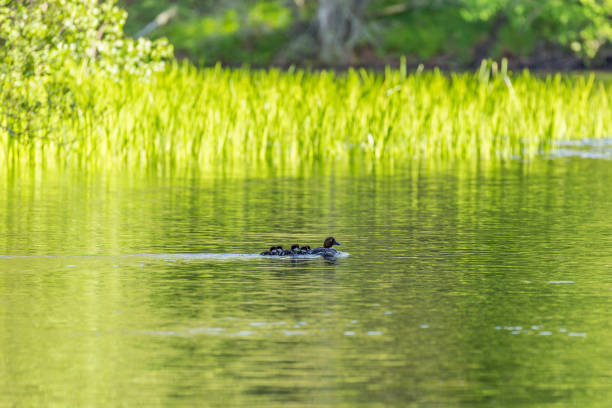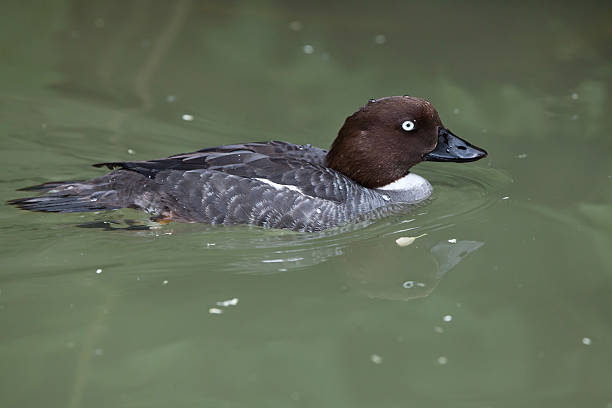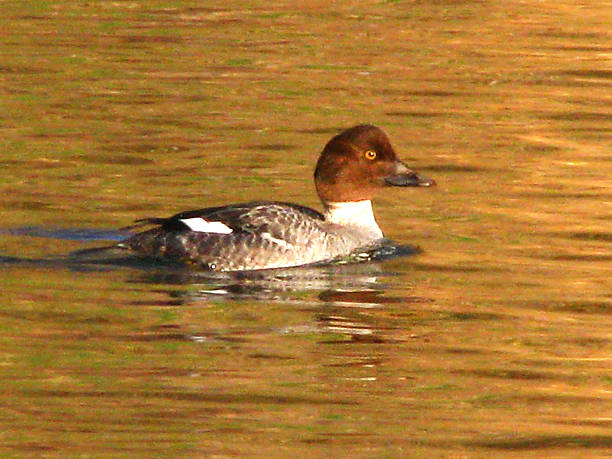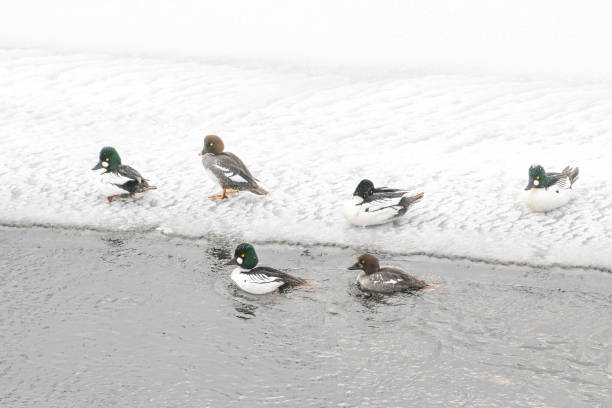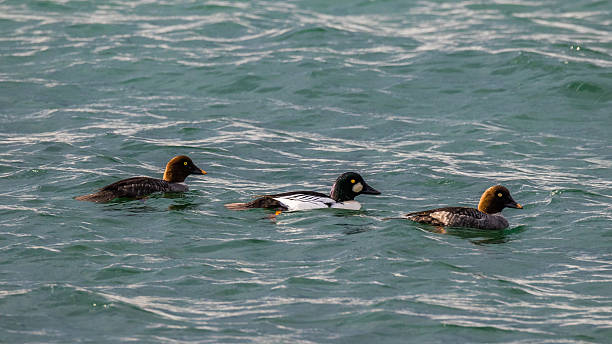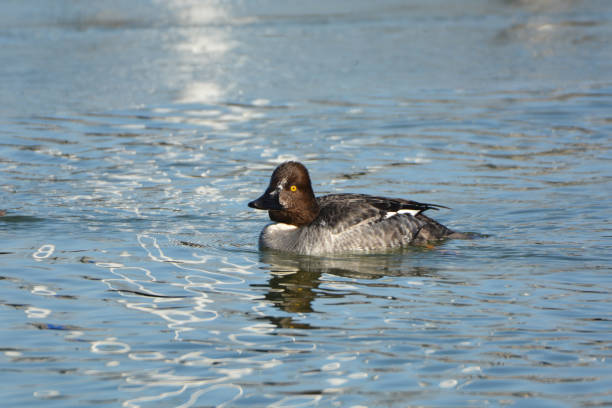
Female Goldeneye Duck Bucephala Clangula Swimming Pictures, Images and Stock Photos
Browse 200+ female goldeneye duck bucephala clangula swimming stock photos and images available, or start a new search to explore more stock photos and images.

Common Golden Eye duck female swimming on water
Goldeneye Duck (Bucephala clangula), Female. Sandy Stream Pond, Baxter State Park, Maine.
Female Common Goldeneye duck
The Barrow's Goldeneye (Bucephala islandica) is a medium-sized diving duck, named after Sir John Barrow, an English statesman and writer. The genus name Bucephala refers to the bulbous shaped head and the species name Islandica means Iceland. The male Barrow’s goldeneye has a black and white body, a purplish glossy head, a bright yellow eye with a white crescent at the front of the face. Adult females have a grayish body and yellow bill. The Barrow's goldeneye is a quiet bird that generally only makes grunts, squeaks and croaks during the breeding season and courtship. Their fast-moving wings create a whistling sound while in flight. The Barrow’s goldeneye is migratory and winters in open inland waters or protected coastal waters. They rely on coastal estuaries as important wintering and stopping places on their migration. Their breeding habitat consists of ponds and wooded lakes in North America as well as some locations in eastern Canada and Iceland. They build their nest in tree cavities. The Barrow’s goldeneye diet is made up of crustaceans, insects and vegetation for which they forage underwater. This Barrow’s goldeneye female was photographed in Puget Sound from Vashon Island at Tahlequah, Washington State, USA.
female goldeneye, male in background
Goldeneye Duck (Bucephala clangula), Female. Sandy Stream Pond, Baxter State Park, Maine.
Common goldeneye (Bucephala clangula) female swimming in water of a lake,
Goldeneye with ducklings in lake at sunrise on the bog
Female Common Goldeneye duck (Bucephala clangula)
Male and Female Common Goldeneye Ducks swimming in a pond.
Female common goldeneye duck swimming in icy pond
The Common Goldeneye (Bucephala clangula) is a medium-sized diving duck of the genus Bucephala. Common goldeneyes are territorial and aggressive. They have elaborate courtship displays. The common goldeneye is named for its golden-yellow eye. Adult males have a dark greenish glossy head with a white circular patch below the eye. Their back is dark and they have a white belly and neck. Adult females have a gray body and brown head. Their legs and feet are orange-yellow. The breeding habitat of the common goldeneye is in the rivers and lakes of the boreal forest across northern North America and northern Russia. They nest in large tree cavities made by woodpeckers and from broken off limbs. They return to the same nests year after year. The goldeneye is a migratory waterfowl and spends the winter in the protected waters of the more temperate latitudes. Their diet is met by foraging underwater for crustaceans, aquatic insects, mollusks, fish eggs and aquatic plants. This female common goldeneye was photographed while swimming at Walnut Canyon Lakes in Flagstaff, Arizona, USA.
The Common Goldeneye (Bucephala clangula) is a medium-sized diving duck of the genus Bucephala. Common goldeneyes are territorial and aggressive. They have elaborate courtship displays. The common goldeneye is named for its golden-yellow eye. Adult males have a dark greenish glossy head with a white circular patch below the eye. Their back is dark and they have a white belly and neck. Adult females have a gray body and brown head. Their legs and feet are orange-yellow. The breeding habitat of the common goldeneye is in the rivers and lakes of the boreal forest across northern North America and northern Russia. They nest in large tree cavities made by woodpeckers and from broken off limbs. They return to the same nests year after year. The goldeneye is a migratory waterfowl and spends the winter in the protected waters of the more temperate latitudes. Their diet is met by foraging underwater for crustaceans, aquatic insects, mollusks, fish eggs and aquatic plants. This female common goldeneye was photographed while swimming at Walnut Canyon Lakes in Flagstaff, Arizona, USA.
The Common Goldeneye (Bucephala clangula) is a medium-sized diving duck of the genus Bucephala. Common goldeneyes are territorial and aggressive. They have elaborate courtship displays. The common goldeneye is named for its golden-yellow eye. Adult males have a dark greenish glossy head with a white circular patch below the eye. Their back is dark and they have a white belly and neck. Adult females have a gray body and brown head. Their legs and feet are orange-yellow. The breeding habitat of the common goldeneye is in the rivers and lakes of the boreal forest across northern North America and northern Russia. They nest in large tree cavities made by woodpeckers and from broken off limbs. They return to the same nests year after year. The goldeneye is a migratory waterfowl and spends the winter in the protected waters of the more temperate latitudes. Their diet is met by foraging underwater for crustaceans, aquatic insects, mollusks, fish eggs and aquatic plants. This female common goldeneye was photographed while swimming at Walnut Canyon Lakes in Flagstaff, Arizona, USA.
Flock with goldeneye ducks swimming in a cold water with ice floes
The Common Goldeneye (Bucephala clangula) is a medium-sized diving duck of the genus Bucephala. Common goldeneyes are territorial and aggressive. They have elaborate courtship displays. The common goldeneye is named for its golden-yellow eye. Adult males have a dark greenish glossy head with a white circular patch below the eye. Their back is dark and they have a white belly and neck. Adult females have a gray body and brown head. Their legs and feet are orange-yellow. The breeding habitat of the common goldeneye is in the rivers and lakes of the boreal forest across northern North America and northern Russia. They nest in large tree cavities made by woodpeckers and from broken off limbs. They return to the same nests year after year. The goldeneye is a migratory waterfowl and spends the winter in the protected waters of the more temperate latitudes. Their diet is met by foraging underwater for crustaceans, aquatic insects, mollusks, fish eggs and aquatic plants. This female common goldeneye was photographed while swimming at Walnut Canyon Lakes in Flagstaff, Arizona, USA.
The Common Goldeneye (Bucephala clangula) is a medium-sized diving duck of the genus Bucephala. Common goldeneyes are territorial and aggressive. They have elaborate courtship displays. The common goldeneye is named for its golden-yellow eye. Adult males have a dark greenish glossy head with a white circular patch below the eye. Their back is dark and they have a white belly and neck. Adult females have a gray body and brown head. Their legs and feet are orange-yellow. The breeding habitat of the common goldeneye is in the rivers and lakes of the boreal forest across northern North America and northern Russia. They nest in large tree cavities made by woodpeckers and from broken off limbs. They return to the same nests year after year. The goldeneye is a migratory waterfowl and spends the winter in the protected waters of the more temperate latitudes. Their diet is met by foraging underwater for crustaceans, aquatic insects, mollusks, fish eggs and aquatic plants. This female common goldeneye was photographed while swimming at Walnut Canyon Lakes in Flagstaff, Arizona, USA.
Goldeneye with ducklings in lake at sunrise
Goldeneye with ducklings in lake at sunrise
A female common goldeneye in a lake in Finland.
The Common Goldeneye (Bucephala clangula) is a medium-sized diving duck of the genus Bucephala. Common goldeneyes are territorial and aggressive. They have elaborate courtship displays. The common goldeneye is named for its golden-yellow eye. Adult males have a dark greenish glossy head with a white circular patch below the eye. Their back is dark and they have a white belly and neck. Adult females have a gray body and brown head. Their legs and feet are orange-yellow. The breeding habitat of the common goldeneye is in the rivers and lakes of the boreal forest across northern North America and northern Russia. They nest in large tree cavities made by woodpeckers and from broken off limbs. They return to the same nests year after year. The goldeneye is a migratory waterfowl and spends the winter in the protected waters of the more temperate latitudes. Their diet is met by foraging underwater for crustaceans, aquatic insects, mollusks, fish eggs and aquatic plants. This female common goldeneye was photographed while swimming at Walnut Canyon Lakes in Flagstaff, Arizona, USA.
A female common goldeneye in a lake in Finland.
The Common Goldeneye (Bucephala clangula) is a medium-sized diving duck of the genus Bucephala. Common goldeneyes are territorial and aggressive. They have elaborate courtship displays. The common goldeneye is named for its golden-yellow eye. Adult males have a dark greenish glossy head with a white circular patch below the eye. Their back is dark and they have a white belly and neck. Adult females have a gray body and brown head. Their legs and feet are orange-yellow. The breeding habitat of the common goldeneye is in the rivers and lakes of the boreal forest across northern North America and northern Russia. They nest in large tree cavities made by woodpeckers and from broken off limbs. They return to the same nests year after year. The goldeneye is a migratory waterfowl and spends the winter in the protected waters of the more temperate latitudes. Their diet is met by foraging underwater for crustaceans, aquatic insects, mollusks, fish eggs and aquatic plants. This female common goldeneye was photographed while swimming at Walnut Canyon Lakes in Flagstaff, Arizona, USA.
Female Common Goldeneye Duck swimming in the lake waters of its natural habitat
Three Common Goldeneye swimming in the river during spring migration
The species is named for its golden-yellow eye. These diving birds forage underwater.
The species is named for its golden-yellow eye. These diving birds forage underwater.
The species is named for its golden-yellow eye. These diving birds forage underwater.
The species is named for its golden-yellow eye. These diving birds forage underwater.
The species is named for its golden-yellow eye. These diving birds forage underwater.
The species is named for its golden-yellow eye. These diving birds forage underwater.
Female Common Goldeneye duck swimming on water
Goldeneye with ducklings in lake at sunrise
Eurasian goldeneye (Bucephala clangula clangula).
Female Common Goldeneye duck swimming on water
Eurasian goldeneye (Bucephala clangula clangula).
A profile view of a female Goldeneye duck, with a brown head and gray body feathers, gliding gracefully across the surface of a gently rippled lake. The water surface has rich warm gold and green color tones. Goldeneye Ducks are freshwater birds.
Common Goldeneye ducks sitting on ice and water of the Lamar river in Yellowstone National Park in Wyoming and Montana. This is near Gardiner and Cooke City, Montana. Larger nearby cities ate Bozeman and Billings, Montana. This river is in the western part of the United States of America (USA).
The species is named for its golden-yellow eye. These diving birds forage underwater.
